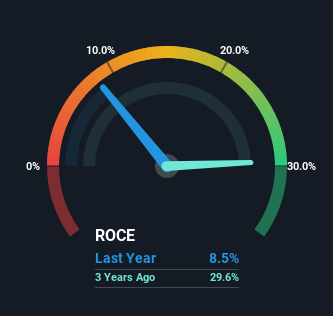- Hong Kong
- /
- Medical Equipment
- /
- SEHK:2172
Investors Could Be Concerned With MicroPort NeuroTech's (HKG:2172) Returns On Capital

To find a multi-bagger stock, what are the underlying trends we should look for in a business? Amongst other things, we'll want to see two things; firstly, a growing return on capital employed (ROCE) and secondly, an expansion in the company's amount of capital employed. Basically this means that a company has profitable initiatives that it can continue to reinvest in, which is a trait of a compounding machine. However, after investigating MicroPort NeuroTech (HKG:2172), we don't think it's current trends fit the mold of a multi-bagger.
What Is Return On Capital Employed (ROCE)?
Just to clarify if you're unsure, ROCE is a metric for evaluating how much pre-tax income (in percentage terms) a company earns on the capital invested in its business. To calculate this metric for MicroPort NeuroTech, this is the formula:
Return on Capital Employed = Earnings Before Interest and Tax (EBIT) ÷ (Total Assets - Current Liabilities)
0.085 = CN¥133m ÷ (CN¥1.8b - CN¥244m) (Based on the trailing twelve months to December 2022).
Thus, MicroPort NeuroTech has an ROCE of 8.5%. On its own, that's a low figure but it's around the 9.6% average generated by the Medical Equipment industry.
View our latest analysis for MicroPort NeuroTech

Above you can see how the current ROCE for MicroPort NeuroTech compares to its prior returns on capital, but there's only so much you can tell from the past. If you'd like, you can check out the forecasts from the analysts covering MicroPort NeuroTech here for free.
How Are Returns Trending?
On the surface, the trend of ROCE at MicroPort NeuroTech doesn't inspire confidence. Around three years ago the returns on capital were 30%, but since then they've fallen to 8.5%. Although, given both revenue and the amount of assets employed in the business have increased, it could suggest the company is investing in growth, and the extra capital has led to a short-term reduction in ROCE. And if the increased capital generates additional returns, the business, and thus shareholders, will benefit in the long run.
On a related note, MicroPort NeuroTech has decreased its current liabilities to 13% of total assets. That could partly explain why the ROCE has dropped. Effectively this means their suppliers or short-term creditors are funding less of the business, which reduces some elements of risk. Some would claim this reduces the business' efficiency at generating ROCE since it is now funding more of the operations with its own money.
The Bottom Line On MicroPort NeuroTech's ROCE
In summary, despite lower returns in the short term, we're encouraged to see that MicroPort NeuroTech is reinvesting for growth and has higher sales as a result. These growth trends haven't led to growth returns though, since the stock has fallen 41% over the last year. As a result, we'd recommend researching this stock further to uncover what other fundamentals of the business can show us.
While MicroPort NeuroTech doesn't shine too bright in this respect, it's still worth seeing if the company is trading at attractive prices. You can find that out with our FREE intrinsic value estimation on our platform.
While MicroPort NeuroTech may not currently earn the highest returns, we've compiled a list of companies that currently earn more than 25% return on equity. Check out this free list here.
New: Manage All Your Stock Portfolios in One Place
We've created the ultimate portfolio companion for stock investors, and it's free.
• Connect an unlimited number of Portfolios and see your total in one currency
• Be alerted to new Warning Signs or Risks via email or mobile
• Track the Fair Value of your stocks
Have feedback on this article? Concerned about the content? Get in touch with us directly. Alternatively, email editorial-team (at) simplywallst.com.
This article by Simply Wall St is general in nature. We provide commentary based on historical data and analyst forecasts only using an unbiased methodology and our articles are not intended to be financial advice. It does not constitute a recommendation to buy or sell any stock, and does not take account of your objectives, or your financial situation. We aim to bring you long-term focused analysis driven by fundamental data. Note that our analysis may not factor in the latest price-sensitive company announcements or qualitative material. Simply Wall St has no position in any stocks mentioned.
About SEHK:2172
MicroPort NeuroScientific
Engages in the research and development, production, and sale of neuro-interventional medical devices in the People’s Republic of China and internationally.
Flawless balance sheet with solid track record.
Market Insights
Community Narratives



